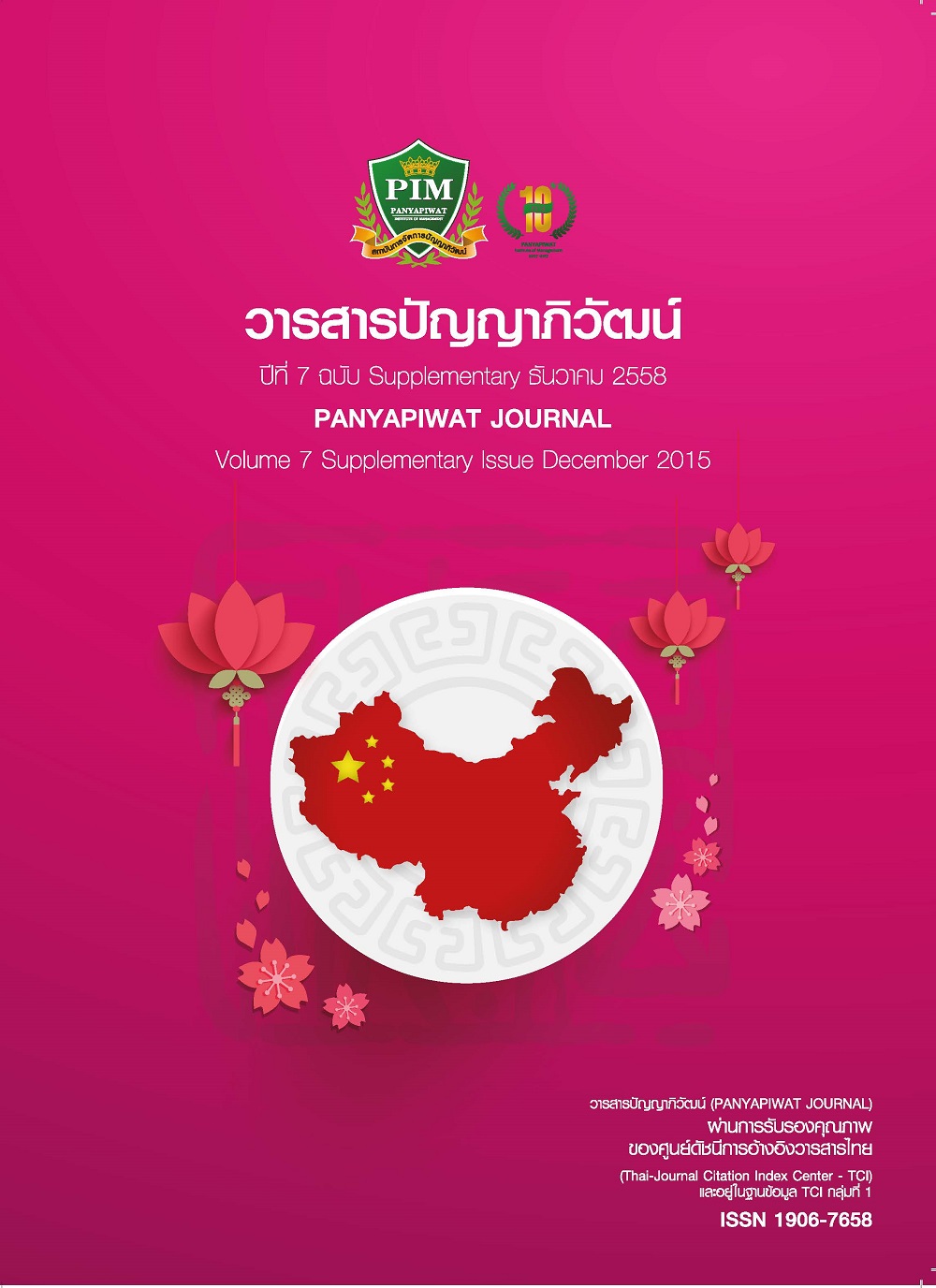INHIBITORY POTENTIAL OF RED PEPPER (Capsicum frutescens Linn.) AGAINST Streptococcus agalactiae INFECTION in Nile Tilapia (Oreochromis niloticus Linn.)
Main Article Content
บทคัดย่อ
This study focuses on the investigation of antimicrobial activity of Red Pepper “Capsicum frutescens Linn.” against S. agalactiae and therapeutic effect of C. frutescens supplemented fish diets on S. agalactiae infected Nile Tilapia (Oreochromis niloticus). Red Pepper was extracted using three different solvents including methanol, 95% ethanol and ethyl acetate. By using agar disc diffusion assay, it was found that methanol and 95% ethanol alcohol extracts of C. frutescens had the highest antimicrobial activity. Based on the analytical of concentration level of antimicrobial activity in C. frutescens as the minimal inhibitory concentration (MIC). Basically it should be extracts the specimens with methanol concentrated. From the results of the extraction of C. frutescens showed that the C. frutescens is lowest MIC with the value of 0.00054 mg/mL. According to the oral administration, fish diets supplemented with C. frutescens at the ratio 1: 9, 1: 19, 1: 29 and 1:39 w/w respectively were given to experimental S. agalactiae infected fish. It was found that the supplemented diets could significantly reduce the mortality rate of the infected fish. In summary, this study showed the inhibitory effects of C. frutescens on S. agalactiae both in vitro and in vivo.
จุดมุ่งหมายในการศึกษาในครั้งนี้เพื่อตรวจสอบประสิทธิภาพในการยับยั้งเชื้อ Streptococcus agalactiae ของพริกขี้หนู ในห้องทดลอง และบำบัดรักษาในปลานิลที่ติดเชื้อดังกล่าวนี้ด้วย โดยนำพริกขี้หนูมาสกัดด้วยสารละลายที่แตกต่างกันสามชนิด ประกอบด้วย เมทานอล เอทานอล 95% และเอทิลแอลกอฮอล์ ทำการทดสอบในห้องทดลองโดยวิธี agar disk diffusion พบว่า พริกขี้หนูที่สกัดด้วย เมทานอล และเอทานอล 95% มีประสิทธิภาพในการยับยั้งสูงสุด และได้นำไปหาความเข้มข้นที่น้อยที่สุดในการยับยั้งเชื้อ (Minimal inhibitory concentration; MIC) พบว่า พริกขี้หนูที่สกัดด้วย เมทานอล มีค่า MIC น้อยที่สุด เท่ากับ 0.00054 มิลลิกรัม/มิลลิลิตร จึงได้นำไปทำการศึกษาในปลานิลที่ติดเชื้อ Streptococcus agalactiae โดยนำไปผสมให้ปลากินในอัตราส่วนพริกต่ออาหารสำเร็จรูปเท่ากับ 1: 9, 1: 19, 1: 29 และ 1: 39 น้ำหนักโดยน้ำหนัก หลังจากทำการศึกษาไปแล้วสองสัปดาห์ พบว่า อาหารที่ผสมพริกขี้หนูทุกอัตราส่วนมีผลทำให้อัตราการรอดตายสูงกว่ากลุ่มที่ไม่มีการผสมพริกขี้หนูในการบำบัดปลานิลที่ติดเชื้อ Streptococcus agalactiae อย่างมีนัยสำคัญ (p<0.05) ซึ่งจากการศึกษาในครั้งนี้แสดงให้เห็นว่า พริกขี้หนูมีประสิทธิภาพในการยับยั้งเชื้อ Streptococcus agalactiae ทั้งในห้องปฏิบัติการและในสัตว์ทดลอง
Article Details
“ข้าพเจ้าและผู้เขียนร่วม (ถ้ามี) ขอรับรองว่า บทความที่เสนอมานี้ยังไม่เคยได้รับการตีพิมพ์และไม่ได้อยู่ระหว่างกระบวนการพิจารณาลงตีพิมพ์ในวารสารหรือแหล่งเผยแพร่อื่นใด ข้าพเจ้าและผู้เขียนร่วมยอมรับหลักเกณฑ์การพิจารณาต้นฉบับ ทั้งยินยอมให้กองบรรณาธิการมีสิทธิ์พิจารณาและตรวจแก้ต้นฉบับได้ตามที่เห็นสมควร พร้อมนี้ขอมอบลิขสิทธิ์บทความที่ได้รับการตีพิมพ์ให้แก่สถาบันการจัดการปัญญาภิวัฒน์หากมีการฟ้องร้องเรื่องการละเมิดลิขสิทธิ์เกี่ยวกับภาพ กราฟ ข้อความส่วนใดส่วนหนึ่งและ/หรือข้อคิดเห็นที่ปรากฏในบทความข้าพเจ้าและผู้เขียนร่วมยินยอมรับผิดชอบแต่เพียงฝ่ายเดียว”
เอกสารอ้างอิง
Abutbul, S., Golan-Goldhirsh, A., Barazani, O. & Zilberg, D. (2004). Use of Rosmarinus officinalis as a treatment against Streptococcus iniae in tilapia (Oreochromis sp.). Aquaculture, 238,97-105.
Alderman, D. J. & Hastings, T. S. (1998). Antibiotic use in aquaculture: development of antibiotic resistance-potential for consumer health risks. Int. J. Food Sci. Technol., 33, 139-155.
Alderman, D. J. & Smith, P. (2001). Development of draft protocols of standard reference methods for antimicrobial agent susceptibility testing of bacteria associated with fish diseases. Aquaculture, 196, 211-243.
Austin, B. & Austin, D. A. (1999). Bacterial Fish Pathogen: Disease in Farmed and Wild Fish. Chichester: Ellis Horwood Ltd.
Bosland, P. W. & Votava, E. J. (2000). Vegetable and Spice Capsicum. London: CAB Publishing.
Caceres, A., Alvarez, A. V., Ovando, A. E. & Samayoa, B. E. (1991). Plants used in Guatemala for the treatment of respiratory disease. 1. Screening of 68 plants against gram positive bacteria. Journal of Ethnopharmacology, 68, 55-61.
Cai, W. Q., Li, S. F. & Ma, J. Y. (2004). Diseases resistance of Nile tilapia (Oreochromisniloticus), blue tilapia (Oreochromis aureus) and their hybrid (female Nile tilapia X male blue tilapia) to Aeromonas sobria. Aquaculture, 229, 79-87.
Chen, H., Chang, M. & Chang, T. (1985). Antibacterial properties of some spice plants before and
after heat treatment. Chinese Journal of Microbiology and Immunology, 18, 190-195.
Cichewicz, R. H. & Thorpe, P. A. (1996). The antimicrobial properties of chilies peppers (Capsicum
species) and their uses in Mayan medicine. Journal of Ethnopharmacology, 52, 61-70.
Cordell, G. A. & Araujo, O. E. (1993). Capsaicin: Identification, nomenclature, and pharmacotherapy. The Annual of Pharmacotherapy, 27, 330-336.
Evans, J, J., Klesius, P. H., Glibert, P. M., Shoemaker, C. A., Al-Sarawi, M. A., Landsberg, J., Duremdez, R., Al-Marzouk, A. & Al-Zenki, S. (2002). Characterization of beta-hemolytic Group B Streptococcus agalactiae in cultured gilthead seabream, Sparus auratus (L.) and wild mullet, Liza klunzingeri (Day), in Kuwait. Journal of Fish Disease, 25, 505-513.
Bensch, A., Gianni, M., Greboval, D., Sanders, J. S. & Hjort, A. (2009). Worldwide review of bottom fisheries in the high seas. Retrieved June 2, 2009, from http://www.fao.org/fisheries/en
Minja, M. M. J. (1989). Collection of Tanzanian medicinal plants for biological activity studies. Proc. 7th Tanzania Vet. Assoc. Sci. Conf. Arusha, Tanzania, December 1989, 67-78.
Mtambo, M. M. A., Mushi, E. J., Kinabo, L. D. B., Maeda-Machang, A., Mwamengele, G. L. M., Yogolo, M. G. S. & Temu, R. P. C. (1999). Evaluation of the efficacy of the crude extracts of Capsicum frutescens, Citrus limon and Opuntia vulgaris against Newcastle disease in domestic fowl in Tanzania. Journal of Ethnopharmacology, 68, 55-61.
Popma, T. J. & Lovshin, L. L. (1995). Worldwide Prospects for Commercial Production of Tilapia. International Center for Aquaculture and Aquatic Environments, Department of Fisheries and Allied Aquaculture Auburn University, Alabama. 42.
Robinson, J. A. & Meyer, F. P. (1966). Streptococcal fish pathogen. Journal of Bacteriology, 92, 512.
SPSS. (1996). SPSS Base Windows User's Guide. Chicago: SPSS Inc.
Surh, Y. J. & Lee, S. S. (1995). Capsaicin, a double-edged sword: Toxicity, metabolism, and chemopreventive potential. Life Sciences, 56, 1845-1855.
Yin, G., Jeney, G., Racz, T., Xu, P., Jun, X. & Jeney, Z. (2006). Effect of two Chinese herbs (Astragalus radix and Scutellaria radix) on non-specific immune response of tilapia, Oreochromis niloticus. Aquaculture, 253, 39-47.


